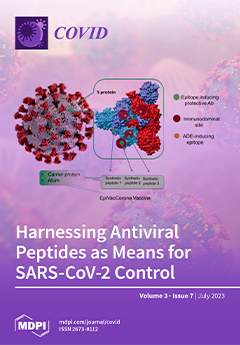Open AccessArticle
Detection of Neutralizing Antibodies in COVID-19 Patients from Steve Biko Academic Hospital Complex: A Pilot Study
by
Mankgopo Kgatle, Joseph Musonda Chalwe, Donald van der Westhuizen, Shuting Xu, Botle Precious Damane, Precious Mathebela, Veronica Ueckermann, Simnikiwe Mayaphi, Hosana Gomes Rodrigues, Pedro Moura-Alves, Honest Ndlovu, Yonwaba Mzizi, Lusanda Zongo, Henry Hairwadzi, Mariza Vorster, Jan Rijn Zeevaart and Mike Sathekge
Viewed by 3770
Abstract
A correlation between neutralization activity after severe acute respiratory syndrome coronavirus 2 (SARS-CoV-2) vaccination and protection against coronavirus disease 2019 (COVID-19) has been demonstrated by several studies. Here, we detect SARS-CoV-2 neutralizing antibody (NAB) production in COVID-19 patients from the Steve Biko Academic
[...] Read more.
A correlation between neutralization activity after severe acute respiratory syndrome coronavirus 2 (SARS-CoV-2) vaccination and protection against coronavirus disease 2019 (COVID-19) has been demonstrated by several studies. Here, we detect SARS-CoV-2 neutralizing antibody (NAB) production in COVID-19 patients from the Steve Biko Academic Hospital complex (SBAH), South Africa (SA). Samples from COVID-19 patients (mild to severe) were collected. SARS-CoV-2 rapid assays, genotyping (Delta and Omicron variants) and enzyme-linked immunosorbent assays (ELISA) were performed. IBM
® Statistical Package for the Social Sciences (SPSS
®) version 28 was used for inferential statistical analysis, and the data were presented using the Prism9 software (version 9.4.1). A total of 137 laboratory-confirmed COVID-19 patients, 12 vaccine recipients and 8 unvaccinated participants were evaluated. The production of SARS-CoV-2 NABs was observed in some of the COVID-19 cases, mainly in severe cases, although this should be noted with caution due to the small sample size of this pilot study. NABs were also observed in asymptomatic participants, with the most being found in recipients (
n = 6) of the BNT162b2 (Pfizer-BioNTech) COVID-19 vaccine. We found a strong presence of NABs in COVID-19 patients, specifically in mild and severe cases. Severe infection was associated with higher NAB production (82%).
Full article
►▼
Show Figures





